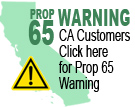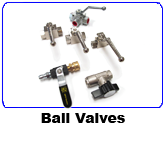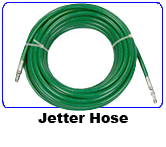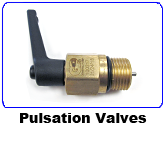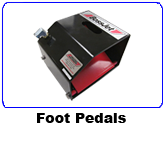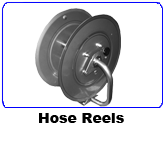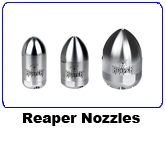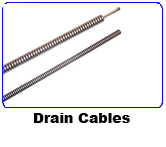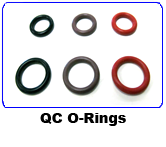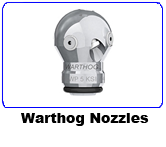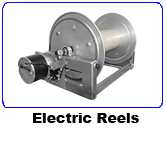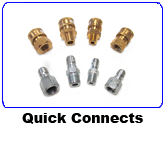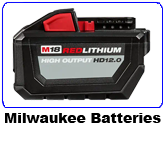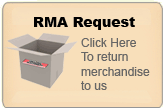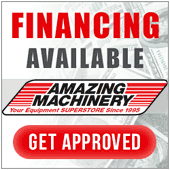

Sewer Jetter FAQ
What is sewer jetting?
Sewer Jetting is the application of directed high pressure water to remove clogs, dirt, grease, and/or grime from pipes to allow them to flow freely. A Pump, along with a jetter tip to create restriction, is used to generate a pressure in some cases powerful enough to cut through concrete. Sewer Jetting is a valuable means of cleaning interior pipe surfaces at incredible speeds.
Which Sewer Jetter should I buy?
We sell a wide variety of Sewer Jetters, accessories and parts. The easiest thing to do is call us toll free at 1-800-504-7435 and tell us your situation. We'll help you pick out the right model for your needs and budget.
What’s more important, pressure (PSI) or water volume (GPM)?
Both PSI and GPM are very important for the optimum performance from a sewer jetter. The pressure lifts the dirt and the water volume carries it away.
What do I do with my machine in the winter?If you live in a climate where it is below freezing you will want to run pump saver antifreeze through your system before putting it to bed at night. When using auto antifreeze the mixture should be 50/50 antifreeze and water. The ideal condition is to store your machine in a climate controlled building but not all of us can do that.
How do I run the antifreeze mixture into my machine?For a cart mounted machine try these simple steps. Using an old garden hose cut off the end with the male thread remaining in about a two to three foot section. Using a funnel insert it into the cut end and funnel pump saver antifreeze or a 50/50 mixture auto antifreeze/water through the pump by pulling the rope start several times until the mixture comes out the other end of the jetter hose. Be sure to drain water from all non-pressurized hoses on your machine to prevent freezing.
For a truck or trailer mounted rig you may add a secondary tank with a capacity of 25-50 gallons, and have it plumbed to your supply line like your regular water tank with ball valves to control the flow. Allow the antifreeze mixture to flow through the high-pressure system and with your jetter tip back into the smaller tank it will recycle its self. You will have to change the antifreeze from time to time, as the mixture will become too diluted. Be sure to drain water from all non-pressurized hoses and tanks on your rig to prevent freezing.
Should I remove the fuel from the tank when storing my sewer jetter?
For safety reasons it's always best to remove the fuel for storage. If you do not plan on storing for longer than a month you can use a stabilizer. You should never store gas inside your home.
How much sewer jetter hose can I use?Using 1/4" jetter hose, the recommended max length is 150' however you can run more. If you choose to use over 150' you may find the hose is not pulling as well into the pipe. On larger machines using 3/8" or 1/2" jetter hose, the recommend max length is 300'.
What do the different Jetter nozzles do?Laser Nozzle or Penetrator Nozzle
Cuts, Dislodges and Flushes blockages
One Forward Jet, Three Backward JetsRam Nozzle
Rams and Flushes tougher debris
Three Backward JetsImpactor Nozzle
Moves sand, grit and light scale which may have accumulated within the line
One Forward Jet, Three Sideward Jets, Six Backwards JetsRotating Nozzle or Spin-Jet Nozzle
Polishes and maximizes line recovery
Two Side Facing Jets, 2 Backward JetsFlusher Nozzle
Flushes loose debris
Six Backward JetsDe-Icer/De-Greaser Nozzle
Removal of heavily blocked lines with grease, hard soap or even ice
Three Forward Angle Jets, Six Backward JetsCornering Nozzle
Navigates around P-Traps and tight bends
One Forward Jet, One Sideward Jet, Three Backwards JetsHow do I clean a clogged nozzle?
Remove the nozzle from your system Using our Nozzle Cleaner or a small piece of wire like a paper clip clear the clog. Flush water backwards through the nozzle and replace it on your sewer jetter. If it is still partially clogged, try again.How often should I replace my nozzles?
This depends on much time you use your machine. A good rule of thumb is if you notice a gradual pressure lose you should replace that tip. Not all tips will wear out at the same time.
Why should I keep my nozzles clean?
A clogged nozzle will not clean as well and can increase the back pressure on your pump causing damage.
What type of oil do I use in my pump?
You want to use Non-detergent oil. You should always refer to your owner's manual to understand what type Non-detergent oil the manufacturer recommends.
I have a hot water supply outside, can I run this through my pump?
No, incoming hot water can damage your pumps seals. Our pumps have a max inlet Water temperature of 80 degrees with a max pump temperature of 140 degrees. If your pump exceeds 140 degrees the thermal relief valve will pop to protect your pump and it will need to be replaced. However you can add an optional Hot Pump Upgrade to most of our machines that will give you a max inlet water temperature of 140 degrees with a max pump temperature of 190 degrees to be used with hot inlet water.
What does by-pass mean?
This allows the pump to circulate water so there is no pressure build up however if you leave your machine in the by-pass mode for longer than two minutes you risk overheating your pumps. We use a thermal relief valve to stop this from happening.
What is a thermal relief valve?
This is a safety feature for your pump. It will keep the pump from burning up if left in the by-pass mode for too long. This valve is set to the max pump temperature rating. If the valve pops you will need to replace it.
If you were not able to find the answer you were looking for in this section, call Amazing Machinery at 1-800-504-7435 to speak with one of our experienced Jetting Staff Members.
ORDER TODAY 1-800-504-7435



Home | Contact Us | Site Index | Links | Jetter FAQ | Articles | Testimonials | Terms of Use | Privacy
Plumbing & Contractor's Equipment since 1995
![]()
Shop By Brand
Business Packages
Sewer Cameras
Viztrac
Milwaukee
Forbest
Ridgid
General Wire
Opticam
Hathorn
Electric Eel
Locators - Line & Sonde
Sewer Jetters
BossJet Sewer Jetters
Ridgid Sewer Jetters
General Sewer Jetters
Electric Eel Sewer Jetters
Trailer Sewer Jetters
Hot Water Jetters
Jetter Conversion Kits
Jetter Hoses
Jetter Nozzles
Nozzle Calculator
Jetter Parts & Accessories
Flex Cable Drain Cleaning
Cyclone
RIDGID
General
Milwaukee
Cable Drain Cleaning
Valor
Ridgid
Milwaukee
Torque Master
General Wire
Electric Eel
Replacement Cables & Parts
Excavation Equipment
Well Drills
Horizontal Boring & Drilling
Trenching Machines
RNVac Industrial Vacuums
Excavation Nozzles
Plumbing Machinery
All Parts & Accessories
Pump Out Systems
Replacement Pumps
Smoke & Smoke Blowers
Pipe Threading Machines
Pipe Patching
Hydrostatic Test Pumps
Leak Detectors
Drain Cleaning Specials
DuroMax Jetters
Viztrac SC Sewer Cameras
Jetter Conversion Kits
BossJet Trailer Jetters
Clearance Specials
Portable Power
Milwaukee Power Supplies
